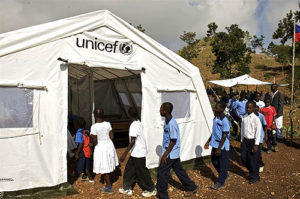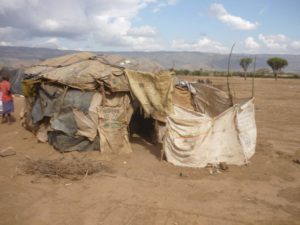PATRICK FARRELL/MIAMI HERALD STAFF
 SCHOOLS A PRIORITY: Youngsters attend classes in tents in Port-au-Prince.
SCHOOLS A PRIORITY: Youngsters attend classes in tents in Port-au-Prince.
Pamela Cox, the World Bank’s vice president for Latin America and the Caribbean, has spearheaded the bank’s recovery and reconstruction efforts in Haiti after its devastating Jan. 12 earthquake.
In her most recent visit to Haiti last month, she met with Prime Minister Jean-Max Bellerive to reaffirm the World Bank’s commitment to Haiti’s long-term recovery.
Here is an edited Q&A with Cox:
Q: What are the main challenges facing Haiti eight months after the earthquake?
A: There is general agreement that priority areas include: housing, where we are working with the government and donors to find a common set of rules on housing reconstruction; getting more schools to reopen this academic year; attracting private sector investments, particularly in the garment industry; and ensuring sustained progress in fiscal and financial systems. Job generation will be the backbone of Haiti’s recovery.
Q: What is your assessment of the international community’s response to the earthquake?
A: Donors responded very generously after the earthquake and in March pledged $5.3 billion toward Haiti’s reconstruction effort for 18 months. However, Haiti’s recovery greatly depends on those resources becoming available in a timely fashion. I recognize that in many cases the approval of funds needs to go through the legislative process, which can slow things down. However, we echo former President Bill Clinton’s call to donors to expedite the delivery of funds.
Q: The World Bank is managing the Haiti Reconstruction Fund. What has been done?
A: Donors pledged about $500 million to the HRF in March. To date, seven donors have confirmed their pledges for a total of $130 million. Brazil was the first country to come forward. In addition, the United States and France have recently announced that they will contribute $100 million and $30 million, respectively.
So far, a $25 million project to help the government provide key services for reconstruction while increasing transparency and addressing corruption has been approved and disbursed, matching a $30 million program of budget support provided by the World Bank. This project was approved the day after it was proposed by the Interim Haitian Reconstruction Commission, which is headed by former President Clinton and Prime Minister Bellerive.
Also, the HRF recently funded two projects approved by the IHRC for a total of $30 million to support debris removal and to establish a partial credit guarantee fund for enterprise development.
The HRF is only one of several sources of post-earthquake reconstruction financing. The bulk of the resources pledged to Haiti — $5.3 billion — will flow through bilateral donors and nongovernmental organizations, and not through the HRF.
Q: What has been the Bank’s total contribution to Haiti’s development?
A: The World Bank pledged $479 million for Haiti’s reconstruction, more than half of which has already been made available. This includes $91 million in new grants from the International Development Agency and trust funds and $98 million to support social and emergency reconstruction. In addition, $39 million, Haiti’s full debt to the World Bank, has been canceled, and $49 million has been made available by the International Finance Corporation to support Haiti’s private sector. Fifteen active IDA investment projects for more than $300 million are disbursing over $10 million per month on average to finance debris management, reconstruction, infrastructure, education, disaster risk management, economic gover-nance, community drive development projects and agriculture. A $30 million grant for budget support also was approved.
Q: There is a sense — at least in media coverage — it takes too long to move projects forward. Why?
A: After a tragedy like this, everyone wants to see things move at a very quick pace. There have been important results on the ground — debris has been cleared from the main roads, most schools have reopened and are not only educating but, in many cases, helping feed children, buildings in Port-au-Prince have been evaluated and people are being allowed to move back into those structures considered safe — but the magnitude of the disaster means that it will take more than months to rebuild Haiti.
While there are positive things happening, it is also important to balance speed with accountability. Everyone wants to make sure that the resources that are being spent in Haiti are really delivering results and will help improve the lives of Haitians.
 Q: You recently visited Haiti and met with the prime minister. What did you achieve?
Q: You recently visited Haiti and met with the prime minister. What did you achieve?
A: It was a very fruitful meeting where we reached a common understanding on the need to focus on three key areas: debris clearance, the whole issue of shelter and housing, and education. Both our Managing Director Sri Mulyani Indrawati and I met with Prime Minister Bellerive and other government officials. Ms. Indrawati, who as Indonesia’s finance minister played a key role in the post-tsunami recovery of Aceh, stressed the importance of the reconstruction commission’s role in setting up priorities for the government and getting donors in one place, which can be difficult for most governments after such a tragedy. Based on the Aceh experience, she emphasized the value of a trust fund to coordinate donors, pool resources together under one umbrella, and co-finance projects with partner agencies.